This Greek yogurt cheesecake is a game-changer! Think creamy, velvety, decadent, slightly tart, light, and perfectly balanced.

My husband is a mean cheese and yogurt eater, so developing a Greek yogurt cheesecake that combined both was a no-brainer. This simple recipe was created through pure experimentation.
I played around with his favorite goat cheese to add depth and Greek yogurt for a nice tang. I added cream cheese, eggs, and real vanilla bean for a luxurious touch (but vanilla extract works too). Like our Baklava Cheesecake or Italian-style Lemon Ricotta Cheesecake, it embraces nostalgia but has a more well-rounded flavor and lighter, airier texture.
There you have it! This creamy-tangy delight is decadent yet fluffy with layers of rich, complex flavor and a crisp graham cracker crust. It’s a cheesecake recipe I’m proud of and believe you will be making many times over. Top this cheesecake with the tart, aromatic, apricot and vanilla compote and you have a mélange of flavors!
This recipe takes planning—you’ll need about an hour and a half to make the cake, and at least 4 hours of chill time in your refrigerator. But that’s what makes it so great for birthday parties or dinner parties. Make it the night before and keep it ready to go in your fridge.
Table of Contents
- What is the History of Cheesecake?
- Greek Yogurt Cheesecake Ingredients
- Ingredient Spotlight
- How to Make Greek Yogurt Cheesecake
- How to Make the Apricot, Vanilla, and Honey Compote
- Tips For The Best Greek Yogurt Cheesecake
- Greek Yogurt Cheesecake: Getting Ahead
- How to Cut Cheesecake
- Ways to Mix it Up
- What to Serve with Greek Yogurt Cheesecake
- You’ll Also Like: Decadent Cake Recipes
- Greek Yogurt Cheesecake with Apricot, Vanilla, and Honey Compote Recipe
- Greek Honey – Thyme, Forest & Wild Herbs
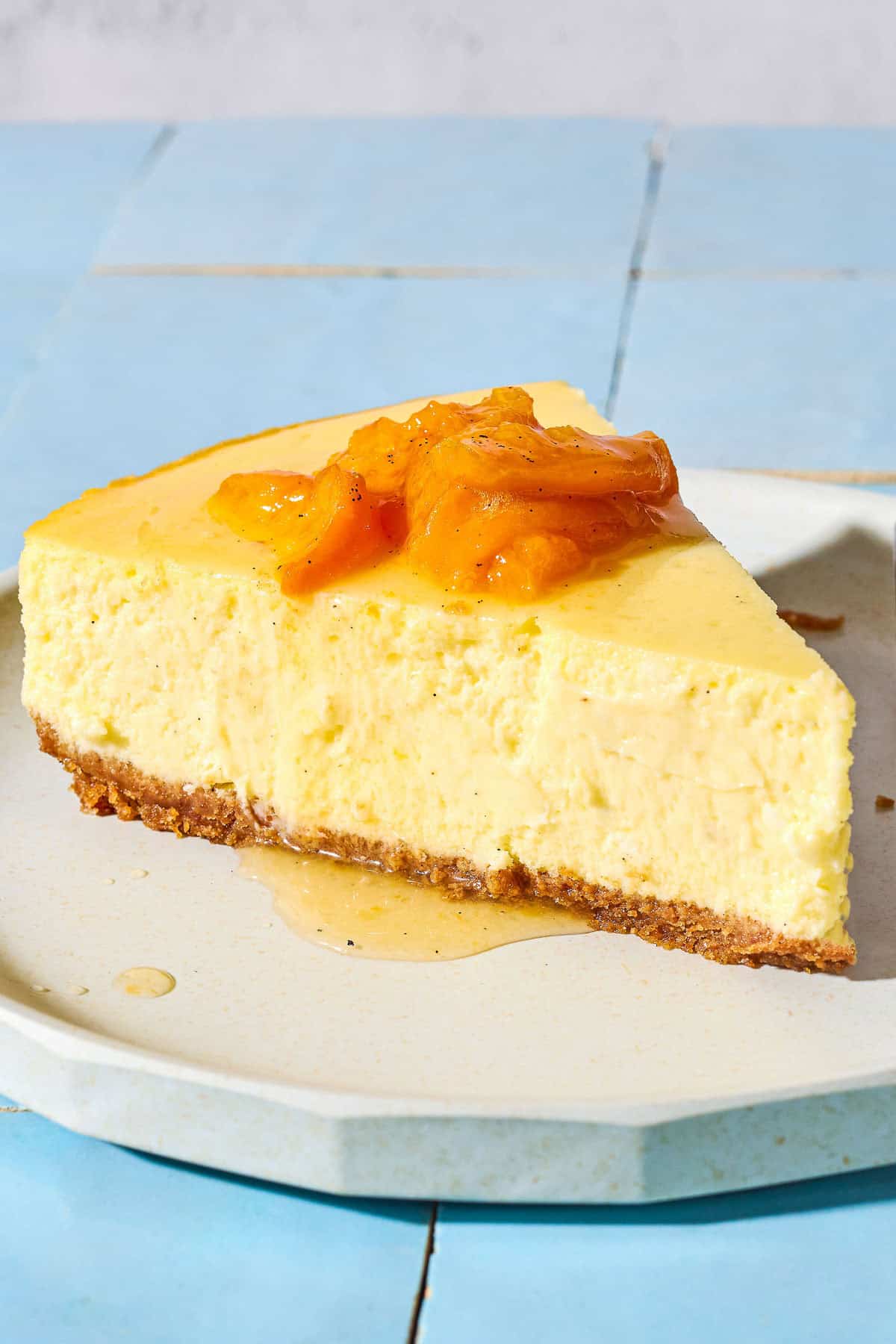
What is the History of Cheesecake?
Years ago, when I first researched the origins of cheesecake, I discovered that cheesecake dates back to Ancient Greek times. It was quite a surprise to me as a Greek. Who would have known that the first cheesecakes were served during the Olympic games in 776 B.C.?
The original cheesecake looked somewhat different from the many recipes and variations we know today. Back in the day, it was made of fresh cheese pounded with flour, cooked on an earthenware griddle, and enjoyed with honey.
In the medieval ages in Europe, cheesecake was transformed to include a pastry base or tart form. It wasn’t until 1872, when a New York farmer was trying to make a soft, low-fat cheese that he unexpectedly made cream cheese—which would then be labeled ‘Philadelphia’—the most widely used cheese for making cheesecakes. This Greek yogurt cheesecake recipe includes inspiration from both eras!
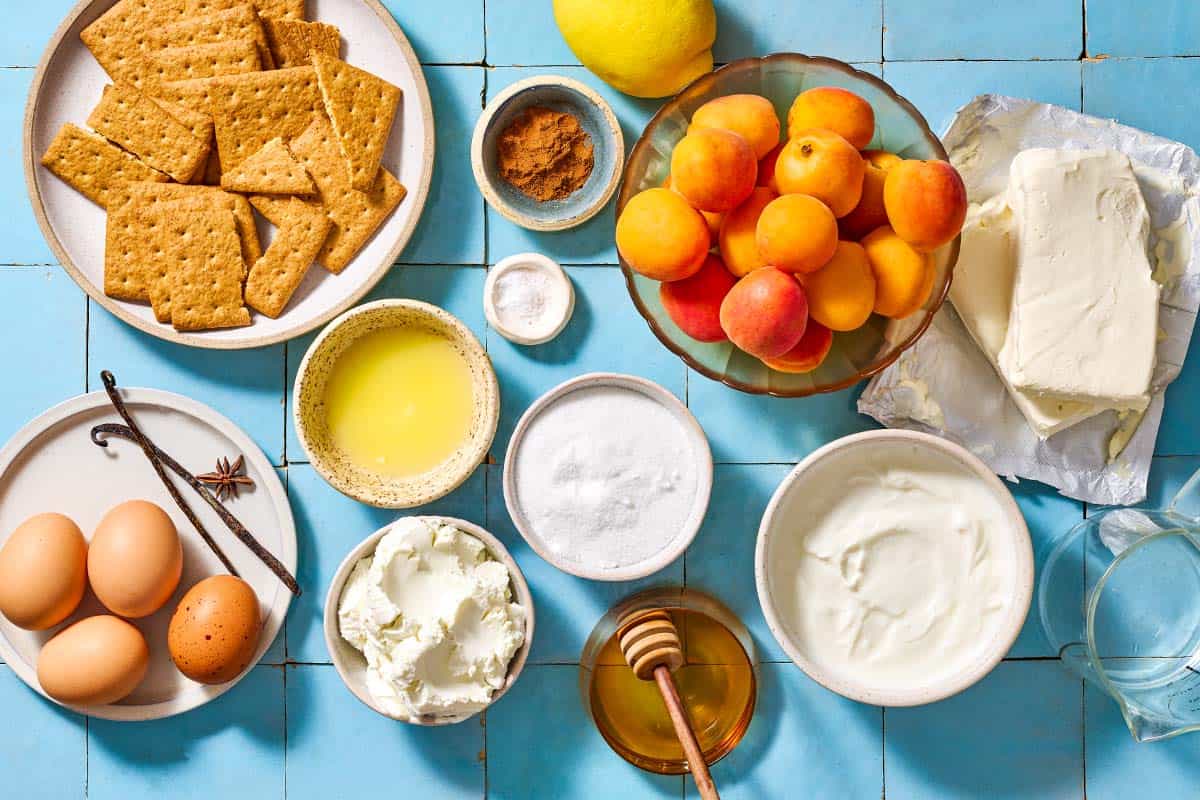
Greek Yogurt Cheesecake Ingredients
Combining goat cheese, cream cheese, and Greek yogurt gives this cheesecake a depth of flavor that makes it truly irresistible. You’ll need:
For the Greek Yogurt Cheesecake
- Cookies: I used Graham crackers, but plain or lightly sweetened crunchy cookies will work for the crust. A crunchy cookie gives the base a great texture and crunch. If you want a gluten-free version, use any gluten-free variety of crunchy cookies.
- Unsalted butter binds the cookie crust and gives it a beautiful, nutty flavor.
- Cinnamon adds a subtle sweetness, spice, and everything nice!
- Salt: This is a must for every sweet treat! A little salt enhances the flavors and balances the sweetness.
- Cream cheese: I always use full-fat cheese. Low fat will work, though you won’t get the same creamy dreamy result. Make sure you use blocks of cream cheese, not cream cheese spread.
- Goat cheese: I add goat cheese to the mixture because it has a higher fatty acid content and less milk protein, which gives the cheesecake a creamier texture. If you prefer not to use goat cheese, add the same quantity of extra cream cheese.
- Greek yogurt: Yogurt is sometimes used is cake as a leavening agent, like with this Easy Yogurt Cake. Here it’s all about the flavor, adding a good tang and richness. I always opt for Greek full-cream yogurt. It has a rich, full flavor, and thick consistency. I don’t recommend low-fat Greek yogurt for this recipe.
- Eggs: Provide structure and help the cheesecake set. They add richness but keep the texture light.
- Granulated sugar: This is not an overly sweet cheesecake, though you can reduce the sugar by 1/2 cup if you’d like.
- Vanilla bean: Adds depth of flavor, and the specks of the vanilla bean also look visually appealing. Vanilla extract works as a substitute.
For the Apricot Compote
- Fresh apricots are the best, as canned apricots release too much liquid. If you can’t find apricots swap in peaches.
- Vanilla bean: Adds depth of flavor, an aromatic quality, and a lovely speckle. Vanilla extract works as a substitute.
- Lemon: The juice’s slight tang works wonderfully well with the apricots and other flavorings. The peel contains pectin, a natural thickener.
- Start anise adds a warm and spicy flavor to the compote.
- Honey: Honey is my first choice, but you could substitute it with 1/2 cup of granulated sugar if that is what you have available. Honey and apricots are a great flavor combination, particularly high-quality Greek honey, like the one from our shop.
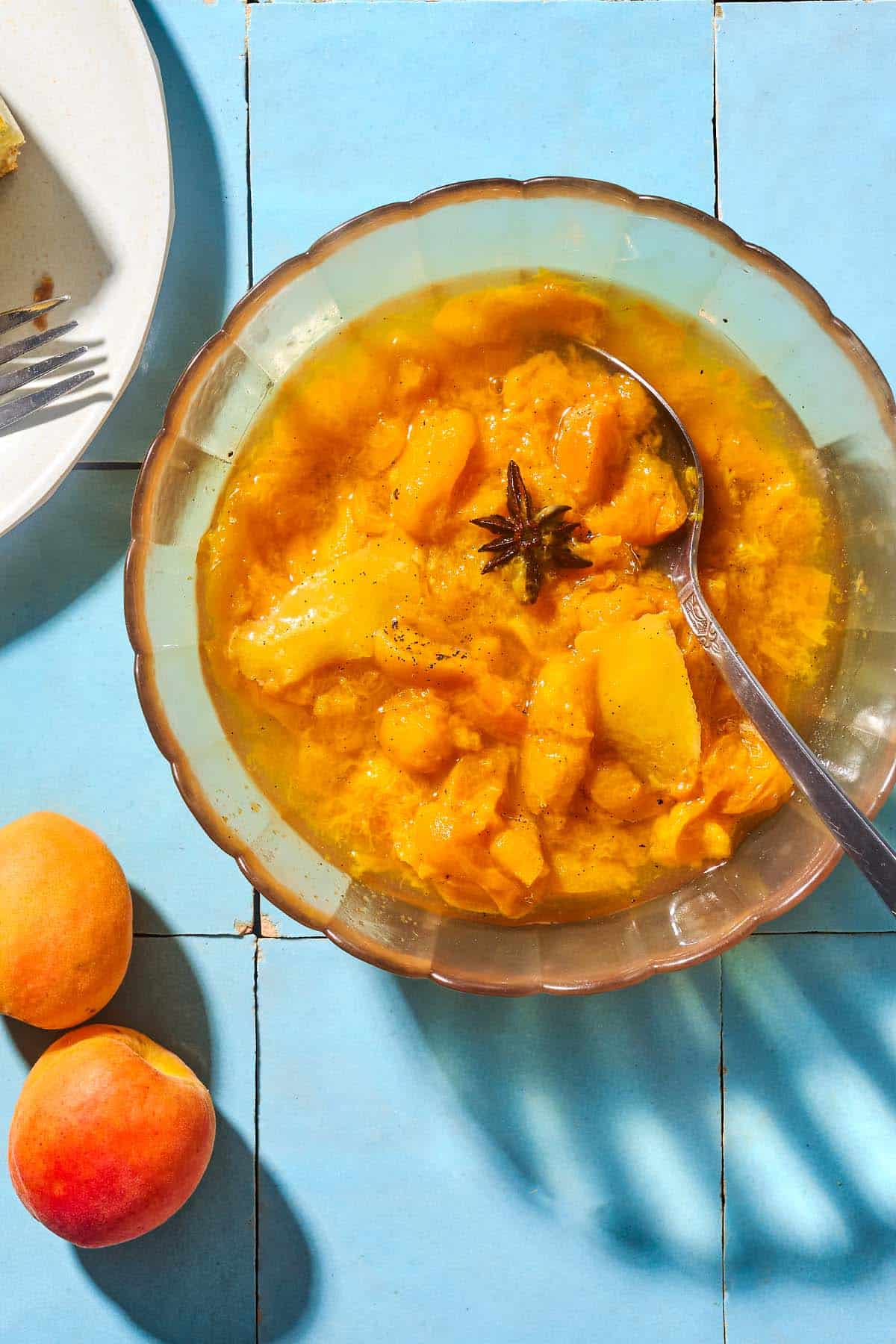
Ingredient Spotlight
A compote is fresh fruit that is cooked down with some sugar and flavorings, either stewed whole or small-cut. Unlike other fruit spreads, less sugar is added making it a healthier, but more perishable, option. Sugar equals longer shelf life to aid in preserving, compotes are to be eaten relatively quickly–up to 2 days.
Compotes are also quicker to make than jam. You can add spices and liquors. Depending on the recipe, they can be more spreadable like a jam, or they can be the texture of pureed fruit. This depends on the size of the fruit and what texture one is trying to achieve. Feel free to chop the apricots into smaller pieces if you prefer a smoother compote.
How to Make Greek Yogurt Cheesecake
First, set the cream cheese, goat cheese, and eggs on the counter for an hour before you start to bake. This will bring them to room temperature, ensuring they’re soft and will combine well. Next:
Make the Crust
- Get ready. Preheat the oven to 375°F. Double wrap the outside of a 9-inch springform cake pan with heavy-duty aluminum foil–make sure it’s the heavy-duty, extra wide kind or water could seep in. Bring a large tea kettle or medium pot filled with water to a boil. Melt 4 tablespoons of unsalted butter.
- Make the graham cracker crust. Crumble 10 sheets of Graham crackers with your hands into a food processor and pulse until they resemble fine breadcrumbs, add 1 ½ teaspoons cinnamon and a pinch of salt, pulse for a few seconds then add the melted butter and pulse until the graham crackers are moistened. Transfer to the springform pan. Use a flat-bottomed cup to press down the crumbs into an even layer across the bottom of the pan. Place the crust in the fridge while proceeding with the next step.
Fill and Bake
- Combine the cheese. In a stand mixer fitted with the paddle attachment or a large mixing bowl with the beater attachments, beat together 2 (8-ounce) room temperature blocks of cream cheese and 8 ounces of goat cheese on low speed until well combined, about 30 to 60 seconds. Scrape down the sides of the bowl and add 1 1/2 cups Greek yogurt. Beat for another 30 to 60 seconds, until light and fluffy. Scrape down the sides of the bowl.
- Add the eggs. Add 4 eggs, one at a time, beating them and scraping down the sides of the bowl between each addition to incorporate. Add 1 3/4 cups granulated sugar and the seeds from 1 vanilla bean and mix on medium-low until all the ingredients are combined smooth, about 1 minute.
- Fill the cheesecake. Remove the crust from the fridge and pour the filling into the crust.
- Make the water bath. Place the foil-wrapped springform pan in a large, deep roasting pan. Pour boiling water into the baking dish, ensuring the water is halfway up the side of the cake pan. You do not want to splash any water into the cheesecake or the foil.
- Bake the cheesecake. Bake until the cheesecake is firm to the touch with a slight wobble in the center, 50 to 60 minutes. Turn the oven off.
- Chill the cheesecake. Remove the roasting pan from the oven and allow the cheesecake to cool in the water bath for 2 hours on the countertop. After 2 hours remove the cheesecake from the water bath. Peel away the aluminum foil and transfer the cheesecake (still in the springform pan) to the refrigerator for at least 4 hours, or better still, overnight. Remove from the pan, slice, and serve with apricot compote (below), either drizzled over top or in a small bowl on the side.
How to Make the Apricot, Vanilla, and Honey Compote
- Prep the apricots. Remove pits from 1 pound of fresh apricots and cut each one into eight slices.
- Make a syrup. In a medium saucepan set over medium heat, add the apricots, 1/4 cup honey, 1/2 vanilla pod (seeds scraped), and 1 star anise. Peel the rind from 1/4 lemon into strips and add, along with the juice and 1/4 cup water. Stir to combine gently.
- Stew the apricots. Cook, stirring occasionally on medium heat, until the apricots release their juices. Continue to simmer for 15 minutes or until the fruit is soft and beginning to fall apart but not completely mushy. Keep cooking for a further 10 minutes if you prefer a thicker consistency.
- Finish and serve. Taste the apricot compote and add a little more honey if desired. Remove the vanilla pod, lemon peel, and star anise. Serve warm or cold on a slice of cheesecake, or store in a sealed jar in your refrigerator for up to 3 days.
Tips For The Best Greek Yogurt Cheesecake
As easy as making a cheesecake, it is also easy to make some fundamental mistakes that can ruin the result. Here are crucial tips to ensure an optimum-tasting cheesecake.
- Ensure the cheese and eggs are at room temperature. This will help with mixing and overall texture. You want a smooth, velvety, and luscious filling. Beating cold ingredients together will result in a chunky, over-beaten cheesecake batter.
- Trust the water bath–it’s worth it, really! A water bath also called a “bain-marie” may sound intimidating, but it’s simple and nothing to fear. Cheesecakes cook better in a humid environment, giving you a far better texture and creamy-dreamy result. The water helps cook the cake evenly and slowly, reducing cracks on the surface while preventing the cake from shrinking as it cools.
- Once you have placed the cheesecake in the oven to bake, you must not open and close to peek! Opening the door while cooking drastically reduces the temperature of your oven and can crack or sink the cake.
- Chill overnight. I know it’s tempting to eat cheesecake the day it is made, but the taste and texture are far better if it remains refrigerated overnight. If you are pressed for time, a minimum of 4 hours will do the trick.
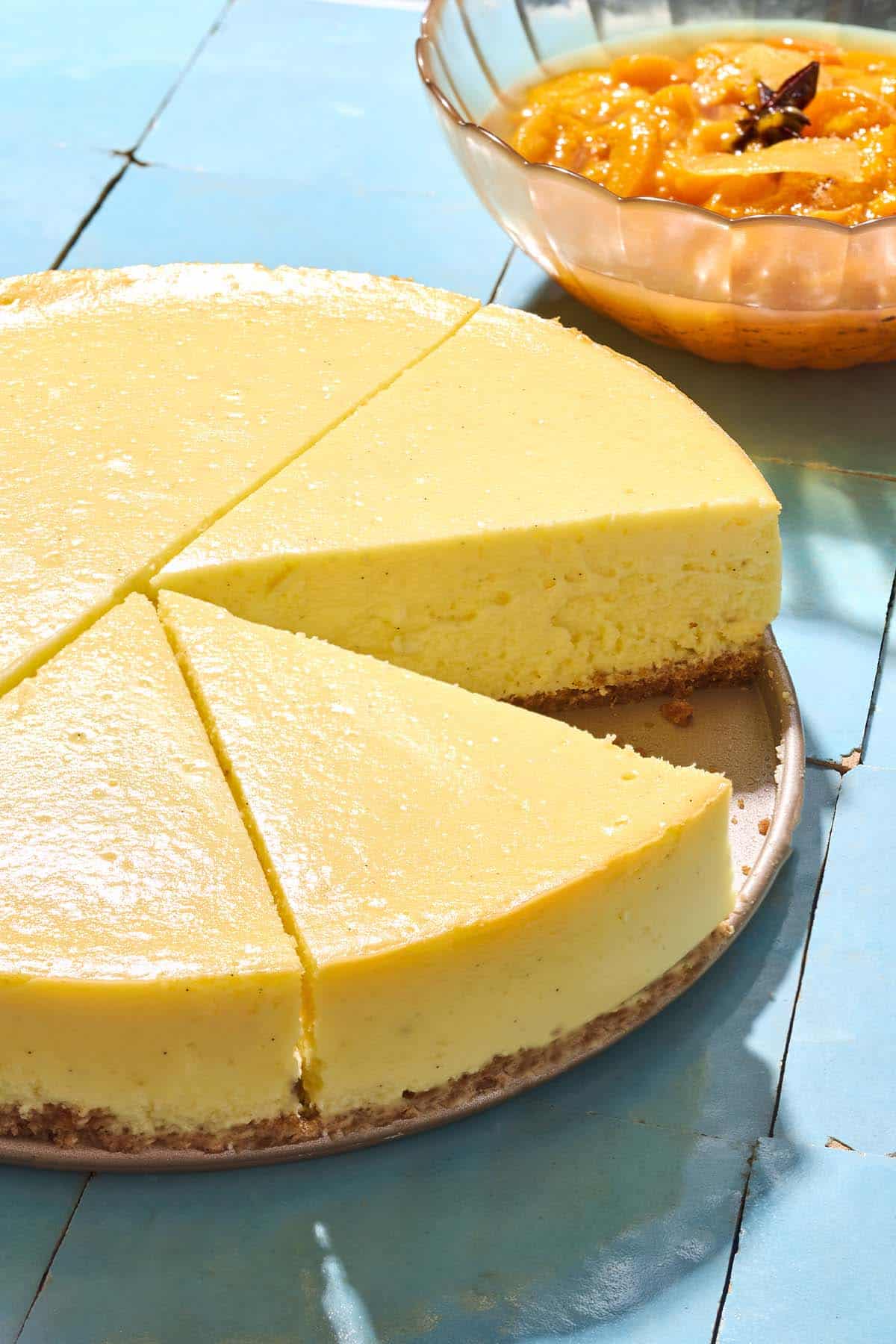
Greek Yogurt Cheesecake: Getting Ahead
The great thing about cheesecake is that it can be baked a day ahead, covered, and refrigerated. Here are more components you can get a head start on:
- Two days ahead: Prepare the apricot compote and keep sealed in your refrigerator.
- Two days ahead: Make the crust, wrap it tightly with plastic, and keep it in your refrigerator.
- One day before: Prepare the filling and keep covered in your refrigerator.
How to Cut Cheesecake
This may sound a little unnecessary, but cheesecake cutting can be messy. A good cheesecake will be velvety and soft, making it hard to get that perfect-looking and neatly cut slice. The best way to achieve this is:
- Dip a sharp, thin knife into hot water and then wipe it dry with a damp paper towel before each cut.
- Repeat this with all the slices.
- This will also help keep the crumbs from sticking to your knife when you cut the slices.
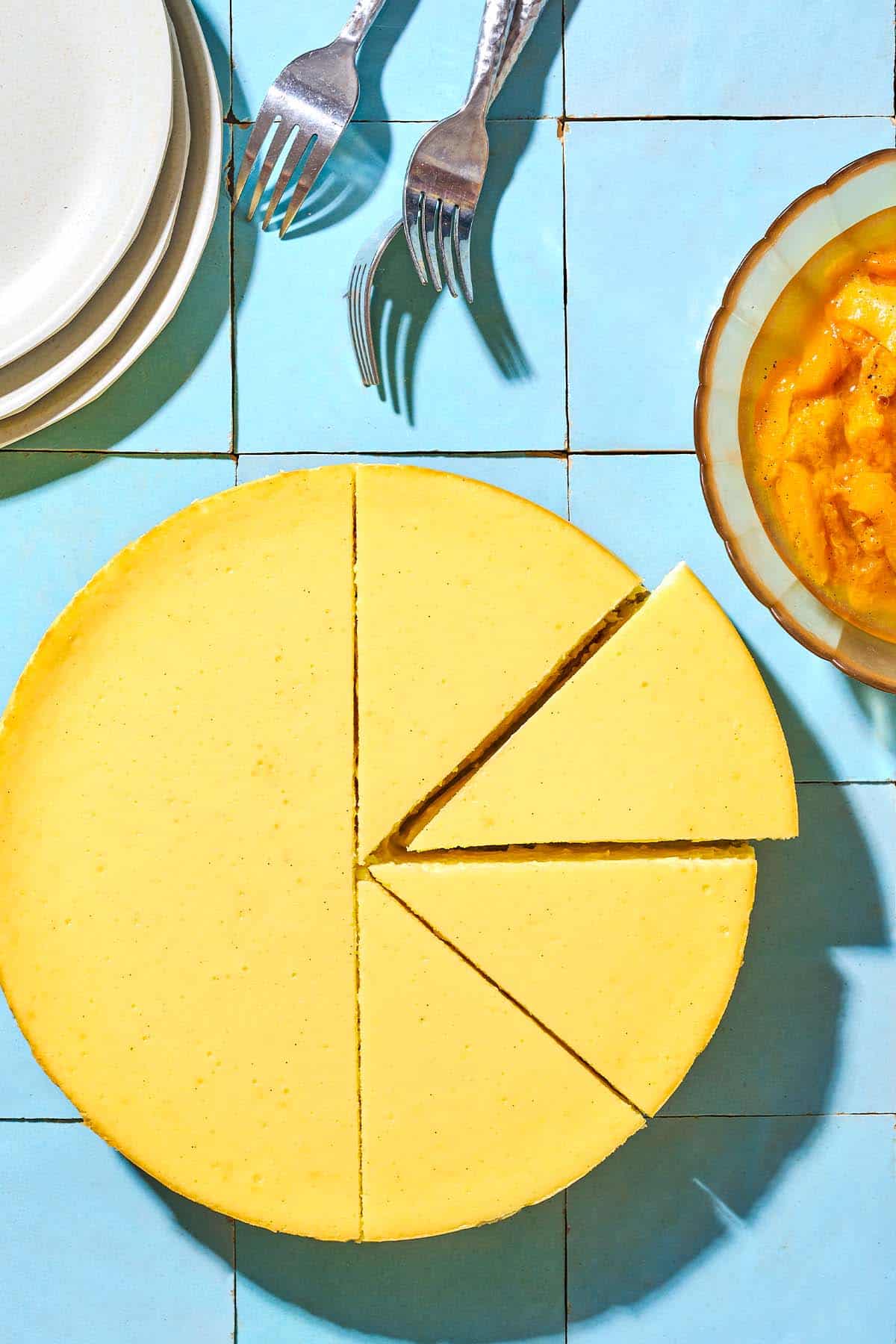
Ways to Mix it Up
Topping choices are endless when it comes to cheesecakes. I have opted for a compote, but feel free to top the cheesecake with anything you like. Note that the cake is so delicious that you may not even want a topping!
More Topping Options
- Fresh fruits.
- Jam of choice, like the Sicilian jams from our shop.
- Strawberry Compote.
- Scoop of ice cream of choice or Frozen Yogurt.
- Drizzle of honey.
Mix up the Crust
- Add a touch of ground cloves.
- Substitute with a crunchy chocolate cookie.
Mix up the Apricot Compote
- Add sweet white wine or orange juice instead of water.
- Add 1/2 teaspoon chopped fresh lavender.
- Zest of half an orange for an extra zing.
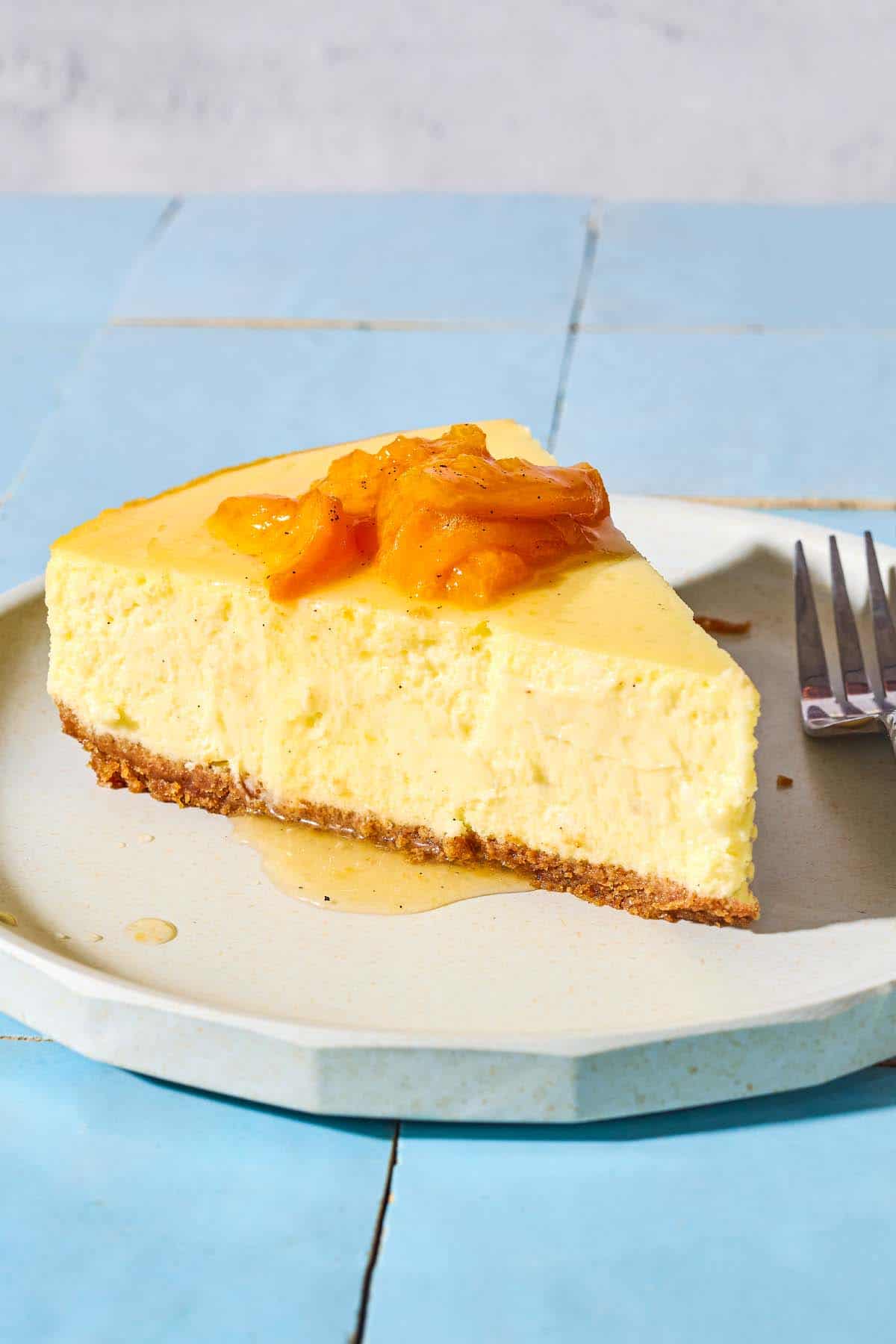
What to Serve with Greek Yogurt Cheesecake
I usually enjoy finishing a satisfying meal by indulging in a slice of cheesecake accompanied by a warm cup of coffee or Black Tea. Some great meal options to pair with this dessert would be Roast Spatchcock Chicken with Citrus & Honey or Mediterranean-Style Roasted Leg of Lamb.
You’ll Also Like: Decadent Cake Recipes
Browse all Mediterranean recipes.
Visit Our Shop.
Greek Yogurt Cheesecake with Apricot, Vanilla, and Honey Compote
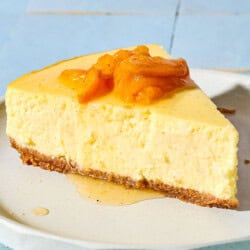
Equipment
- Heavy-duty (extra wide) aluminum foil
Ingredients
For the Crust
- 10 Graham cracker sheets (152g)
- 4 tablespoons unsalted butter, melted
- 1 1/2 teaspoons ground cinnamon
- 1 pinch kosher salt
For the Filling
- 2 (8-ounce) blocks cream cheese, at room temperature
- 8 ounces goat cheese, at room temperature
- 12 ounces (1 1/2 cups) Greek yogurt, at room temperature
- 4 whole eggs, at room temperature
- 1 3/4 cups (340 grams) granulated sugar
- 1 vanilla pod, seeds scraped (or 1 tablespoon vanilla extract)
For the Apricot, Vanilla, and Honey Compote (Optional)
- 1 pound fresh apricots
- ¼ cup runny honey
- ½ vanilla pod, seeds scraped (or 1 teaspoon vanilla extract)
- 1 star anise
- 1/4 lemon, rind peeled into strips and flesh juiced
- 1/4 cup water
Instructions
Make the Crust
- Get ready. Preheat the oven to 375°F. Double wrap the outside of a 9-inch springform cake pan with heavy-duty aluminum foil–make sure it’s the heavy-duty, extra wide kind or water could seep in. Bring a large tea kettle or medium pot filled with water to a boil.
- Make the graham cracker crust. Crumble the Graham crackers with your hands into a food processor and pulse until they resemble fine breadcrumbs. Add the cinnamon and a pinch of salt and pulse for a few seconds. Add the melted butter and pulse until the graham crackers are moistened.
- Chill the crust. Transfer to the springform pan. Use a flat-bottomed cup to press down the crumbs into an even layer across the bottom of the pan. Place the crust in the fridge while proceeding with the next step.
Fill and Bake
- Combine the cheeses and yogurt. In a stand mixer fitted with the paddle attachment or a large mixing bowl with the beater attachments, beat together the cream cheese and goat cheese on low speed until well combined, about 30 to 60 seconds. Scrape down the sides of the bowl and add the Greek yogurt. Beat for another 30 to 60 seconds, until light and fluffy.
- Incorporate the eggs. Scrape down the sides of the bowl. Add the eggs, one at a time, beating them and scraping down the sides of the bowl between each addition to incorporate. Add the granulated sugar and vanilla bean (or extract) and mix on medium-low until all the ingredients are combined smooth, about 1 minute.
- Fill the cheesecake. Remove the crust from the fridge and pour the filling into the crust.
- Make the water bath. Place the foil-wrapped springform pan in a large, deep roasting pan. Pour boiling water into the baking dish, ensuring the water is halfway up the side of the cake pan. You do not want to splash any water into the cheesecake or the foil.
- Bake the cheesecake. Bake in a 375°F until the cheesecake is firm to the touch with a slight wobble in the center, 50 to 60 minutes. Turn the oven off.
- Chill the cheesecake. Remove the roasting pan from the oven and allow the cheesecake to cool in the water bath for 2 hours on the countertop. After 2 hours, remove the cheesecake from the water bath. Peel away the aluminum foil and transfer the cheesecake (while still in the springform pan) to the refrigerator for at least 4 hours, or better still, overnight. Remove from the pan, slice, and serve with apricot compote, either drizzled over top or in a small bowl on the side.
Optional: Make the Apricot, Vanilla, and Honey Compote
- Prep the apricots. Remove pits from 1 pound of fresh apricots and cut each one into eight slices.
- Make a syrup. In a medium saucepan over medium heat, add the apricots, honey, vanilla bean seeds and pod, star anise, lemon juice, peel, and water. Stir to combine gently.
- Stew the apricots. Cook, stirring occasionally on medium heat, until the apricots release their juices. Continue to simmer for 15 minutes or until the fruit is soft and beginning to fall apart but not completely mushy. Keep cooking for a further 10 minutes if you prefer a thicker consistency.
- Finish and serve. Taste the apricot compote and add a little more honey if desired. Remove the vanilla pod, lemon peel, and star anise. Serve warm or cold on a slice of cheesecake, or store in a sealed jar in your refrigerator for up to 2 days.
Notes
- Shop this recipe: Visit our shop to browse quality Mediterranean ingredients including the honey used in this recipe.
- Ensure the cheese and eggs are at room temperature before starting the recipe. This will help with mixing and overall texture. You want a smooth, velvety, and luscious filling. Beating cold ingredients together will result in a chunky, over-beaten cheesecake batter.
- Once you have placed the cheesecake in the oven to bake, you must not open and close to peek! Opening the door while cooking drastically reduces the temperature of your oven and can crack or sink the cake.
- To remove the vanilla bean from the pod: Slice the pod in half lengthwise from top to bottom. Use a small knife to carefully scrape out the seeds.
- Why wrap the cake pan with foil? This ensures that no water seeps into the cheesecake and that no cheese mixture leaks out while cooking in the water bath.
- Nutrition calculation is for the yogurt cheesecake only.
Nutrition
Greek Honey – Thyme, Forest & Wild Herbs
Drizzle this high quality Greek honey over your cheesecake for a delicate sweetness, or to your Apricot compote.
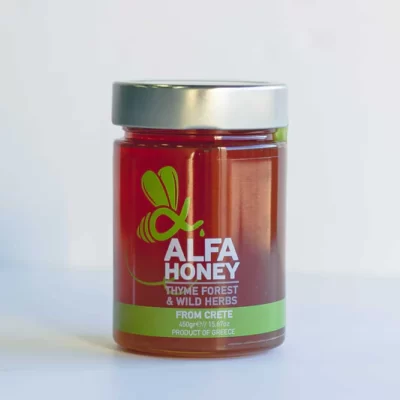
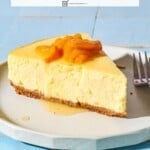
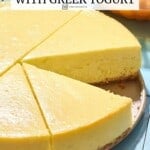

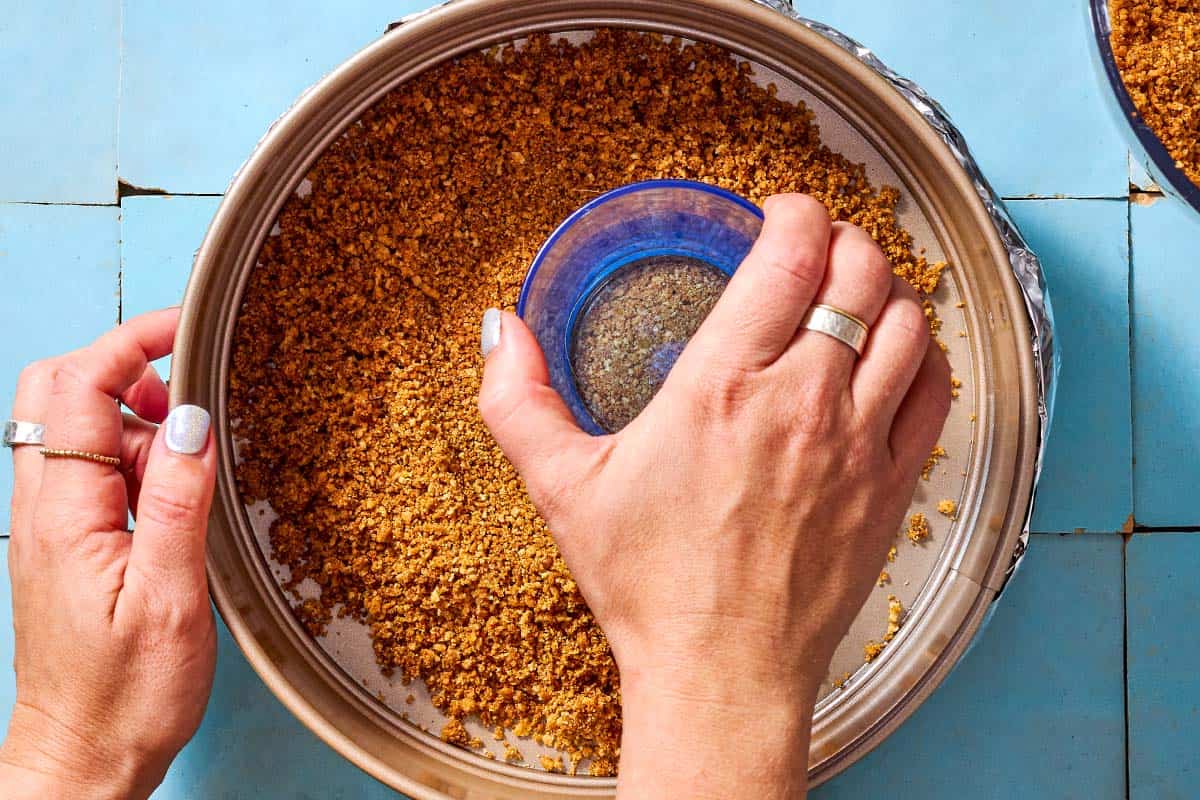
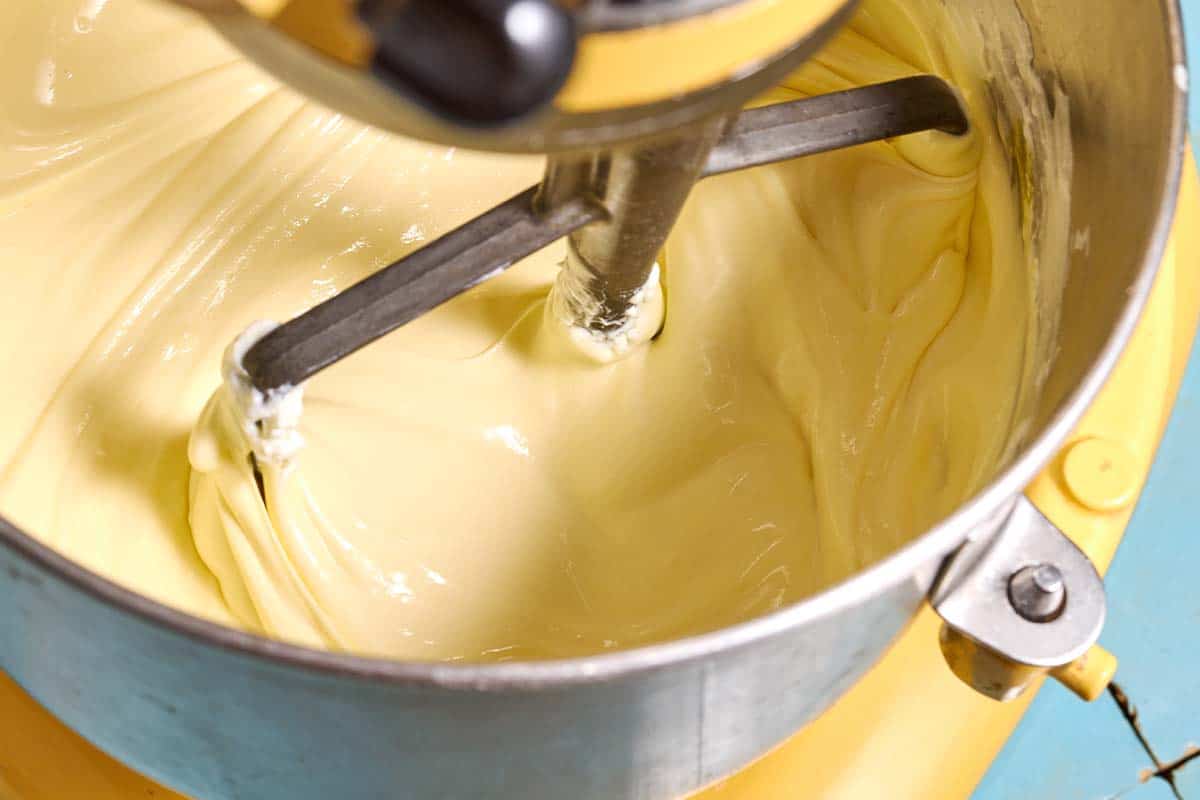
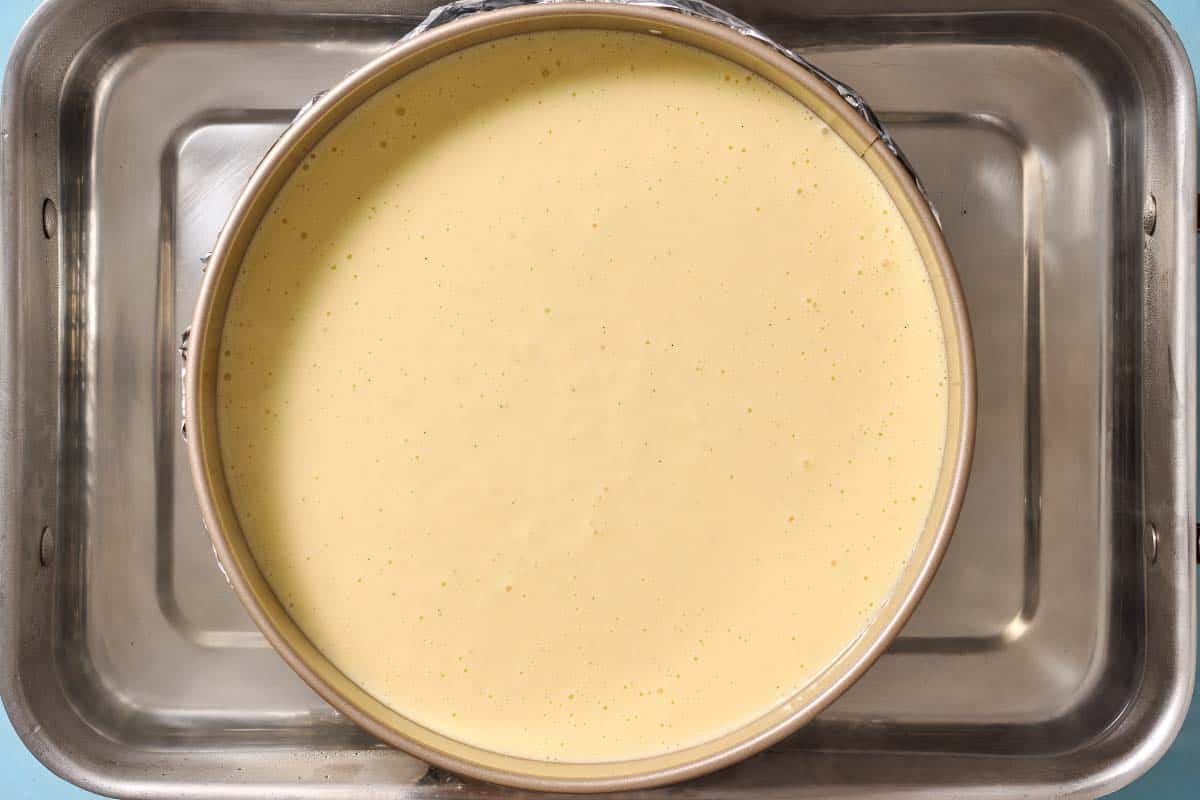
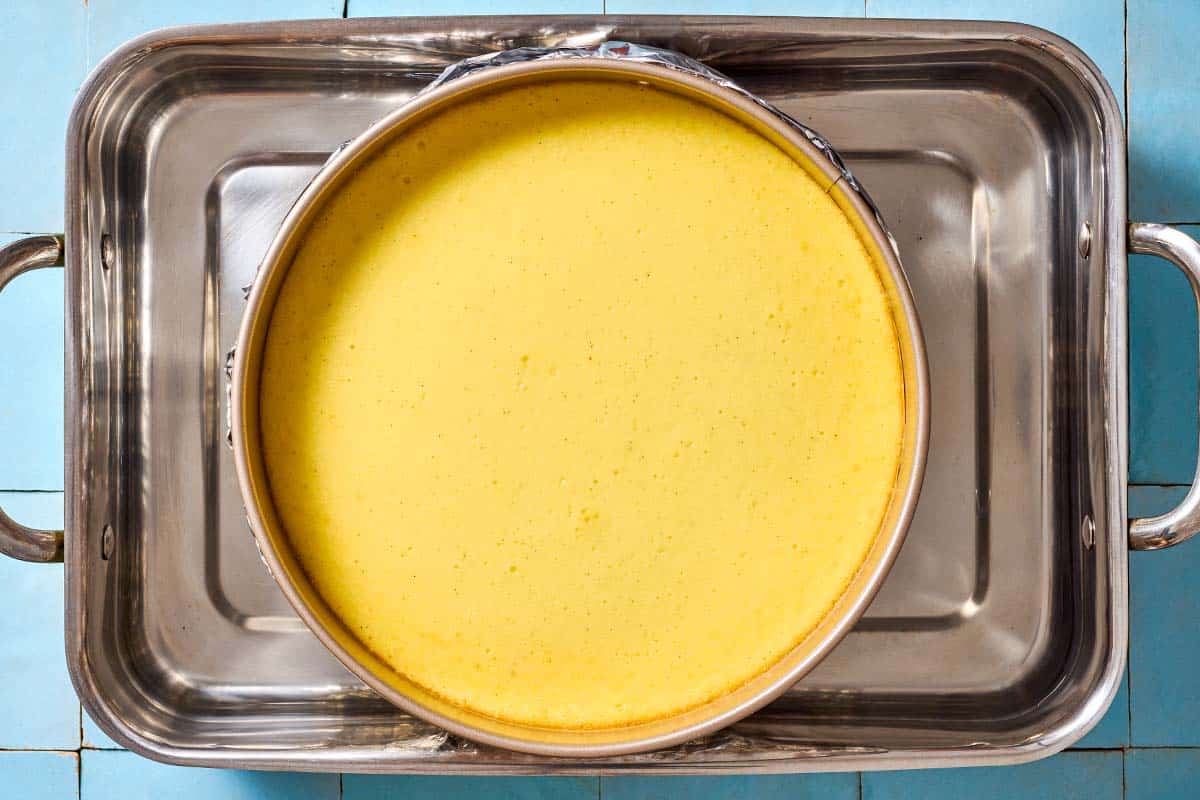
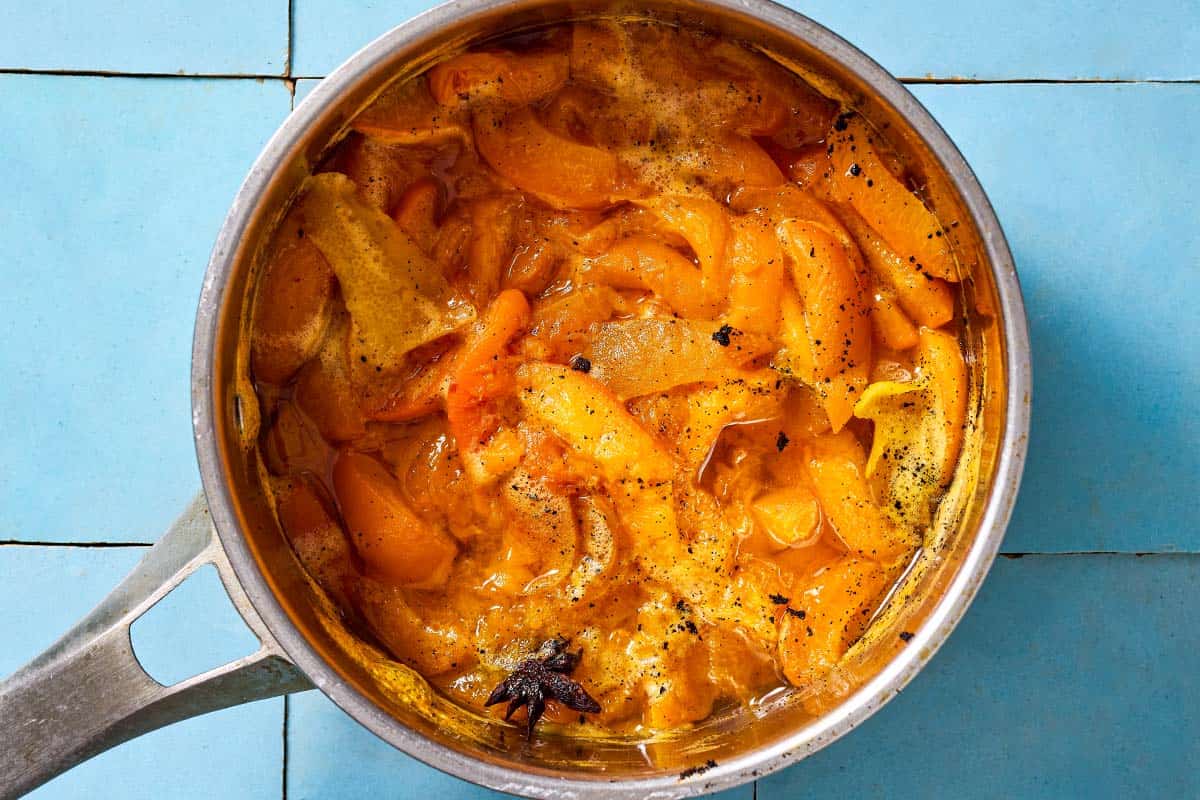
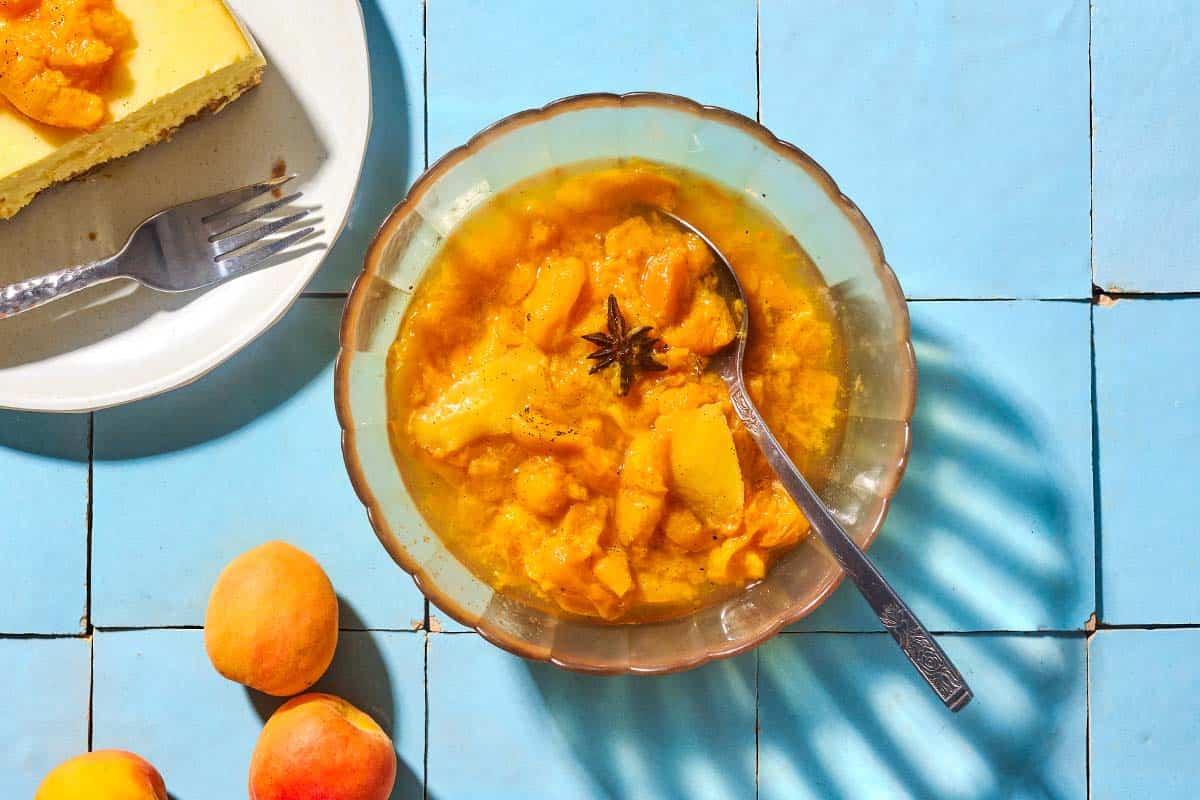
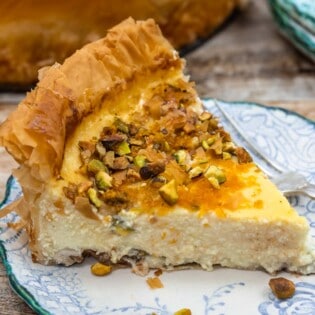
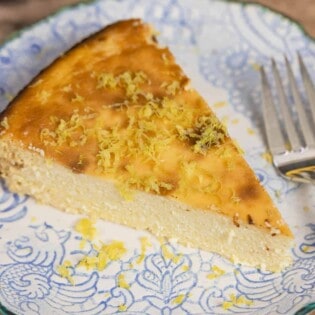
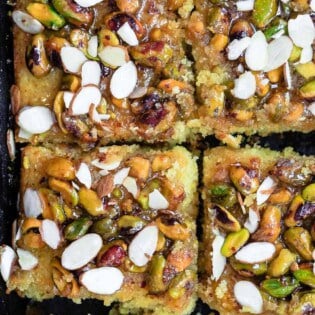
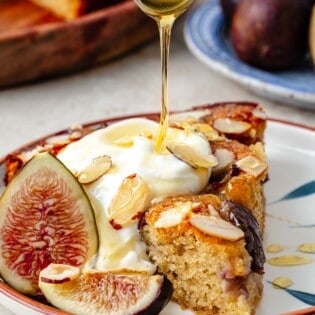
Does this freeze well?
Second time making this cake, used honey goat cheese and vanilla Greek yogurt. Massive hit!
Hi, Kathleen! I’m Summer and I work here at The Mediterranean Dish. I’m glad you love this cheesecake. It’s a favorite of mine as well. I haven’t frozen this particular cheesecake before, but I have frozen many others in the past and it’s always worked out. Once the cheesecake cools, I place it (unwrapped) in the freezer for about an hour just to firm it up. Then place a round of parchment over the top, and wrap it first in plastic wrap then in aluminum foil. I have frozen cheesecakes for up to 3 months before and no one was ever the wiser. Good luck!
Hi,
Would love this recipe in an English measurement format, and we use generally Philidelphia cream cheese in cheese cakes, is that the same as blocks of cream cheese?
Many Thanks Warren
Hi, Warren. Yes, that is pretty much what we’re referring to when we mean “blocks”. You can click here to see and example.
Very good. Paired with Strawberry compote on this site. 👌also made the Lemon Ricotta cheesecake . Like both , different tastes . I did not have apricots, but love apricot too.
So rich and creamy with a distinctive unique flavor and a big hit! This was also my first attempt at making a cheesecake.
So glad it was a win, Dani!
Is there some way to use apricot jam in lieu of fresh apricots in the compote?
Hi, Janet. I would not use the jam in lieu of the fresh apricots. The would make the compote way to sweet. You could simply use the jam instead of the compote itself. Enjoy!
We really enjoyed this light, slightly addictive cheesecake. I skipped the compote and opted for fresh berries and whipped cream on top. To make this gluten free I used gluten free cookies which I put in a food processor and added the melted butter. I also made one with no crust which we enjoyed as well. It is a very light texture so it fell apart as I cut it a little bit, but we didn’t care. This could also be because I used mascarpone cheese instead of goat cheese because I didn’t have any goat cheese except feta.
So glad you enjoyed it, Michelle!